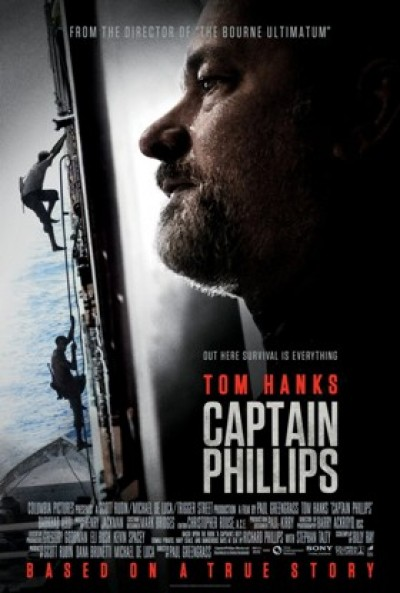“A little air might do him some good”
Despite my affinity for director Paul Greengrass‘ entries to the Bourne Saga, his cinéma vérité style will always in my opinion be better suited for gritty, true-life tales such as the contemporary classics Bloody Sunday and United 93. (We’ll just forget Green Zone ever squeezed its way into his oeuvre.) As a result, his attachment to Richard Phillips‘ harrowing tale of getting hijacked by Somali pirates and subsequently kidnapped as a hostage for ten million dollars was a perfect marriage from the beginning. The Brit simply has an eye for dramatic suspense and emotionally heavy sparks of real, common man heroism—two things the experience depicted in Captain Phillips has in spades. Joined by a captivating performance from Tom Hanks at the lead and the enterprise rightfully found Oscar buzz before it even debuted.
It’s for good reason too as the film is one that can’t help but draw you into its grip. We obviously know Phillips survived the ordeal to write the book—A Captain’s Duty—on which it’s based with Stephan Talty, so our interest really hinges upon the details leading up to his rescue rather than the “what if” of it happening. Adapted by Billy Ray and researched extensively by Greengrass himself to ensure it would be as close to true as possible—a harder task than one might expect with a number of lawsuits filed by Maersk Alabama crewmembers stating Phillips ignored warnings and may have wanted to be taken—what’s ultimately shown onscreen can still never be one-hundred percent fact. It’s instead merely what Phillips himself calls a portrayal of his experience above reality.
Such is the entertainment business and you can’t necessarily fault them for polishing things up here and there to craft a better story. The truth of the matter is that unless you were somehow a fly on the wall as it all occurred, any account is by definition a subjective interpretation filtered through uncontrollable emotions and fractured memories. It becomes the filmmakers’ task to shroud everything in an air of authenticity from the vessels involved, backgrounds of the Somali fishermen-turned-pirates, and military protocols used to diffuse the situation. This isn’t a documentary, nor does it pretend to be one. Greengrass’ shaky-cam aesthetic and in-your-face close-ups may help us feel like we’re on the ship, but the fact it’s based on one man’s account should always be taken with a grain of salt where verisimilitude is concerned.
It is very easy to lose yourself into the film, however, and that is a testament to all involved. From the personal conversation between Phillips and his wife Andrea (Catherine Keener) about their children on the road to the airport at the beginning to his taskmaster severity onboard the ship trying to break-in a new crew to the gym class-esque process of Muse (Barkhad Abdi) picking his pirating crew from a large contingent of villagers looking for a chance at monetary glory, we’re watching as banal moments on any other normal day become crucial to the mentalities and evolutions of those men thrust together on April 8, 2009. This is what it’s like to have a simple drill turn into a full-fledged attack and the sort of improvisation necessary to survive the danger and fear.
Despite a ton of familiar faces on the Maersk—Michael Chernus, David Warshofsky, Corey Johnson, andChris Mulkey—doing their jobs, complaining about unions and ill-equipped security measures, or going above and beyond to risk their lives and force the pirates off their deck, the film is titled Captain Phillipsand therefore must keep that subject in frame as much of the duration as possible. He is the one Muse holds at gunpoint while searching the ship for its hidden crew and the one bravely holding down his walkie-talkie button while narrating his movements out loud so those listening can make inferred decisions on what to do next. If we’re about to spend half the film with him inside a cramped lifeboat, we must align ourselves with him as everything escalates out of control.
Once alone in the lifeboat, however, our vantage point does change as Phillips no longer holds any power. The second half of the movie pits the Navy against Muse’s band of highly-strung bundles of nerves and impatience while Phillips is made to wait and see what will happen next like us. This is where Hanks raises his game from playing aloof with home field advantage to truly being blind and alone, hoping the checklist in his head for what needs to happen outside for his survival will start getting crossed off. It’s also where his captors transform from cocky villains to an even more volatile vulnerability as every step towards Phillips’ rescue by the SEAL Team Commander (Max Martini) on the water conversely means one step further from a calm and collected atmosphere inside.
These first-time actors shine while cooped up in their tiny prison. Faysal Ahmed’s Najee lets his aggressive anger and lack of trust get the better of him, Mahat M. Ali’s Elmi starts feeling the walls closing in, and Barkhad Abdirahman’s first-time pirate Bilal finds his youthful innocence breaking through the steely façade he never could conjure. It’s Abdi as their leader, however, who actually steals scenes from Hanks. Introspective in thinking what damage his next move might bring, you believe his Muse when admitting no one was supposed to get hurt. His actions are inexcusable and yet he somehow earns our sympathy as we wonder if maybe there really were no other occupational avenues to follow. He can’t stop believing victory is attainable because neither defeat nor retreat can end in anything but death.
Score: 8/10
Rating: PG-13 | Runtime: 134 minutes | Release Date: October 11th, 2013 (USA)
Studio: Sony Pictures Releasing / Columbia Pictures
Director(s): Paul Greengrass
Writer(s): Billy Ray / Richard Phillips & Stephan Talty (book A Captain’s Duty: Somali Pirates, Navy SEALS, and Dangerous Days at Sea

